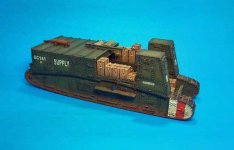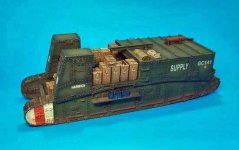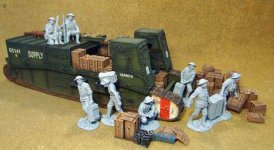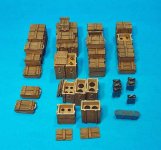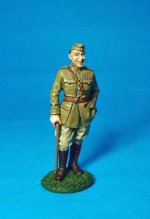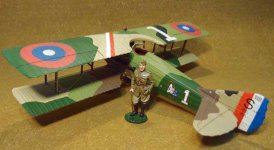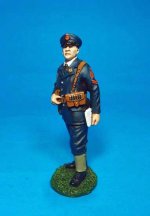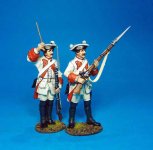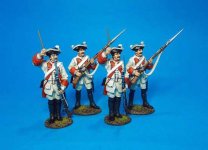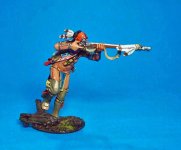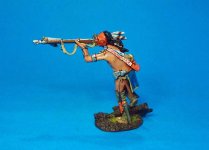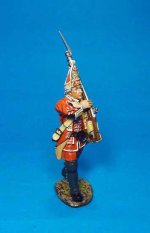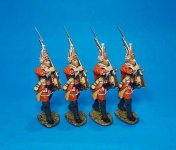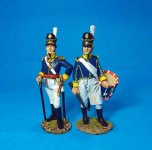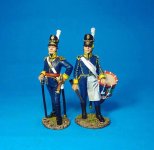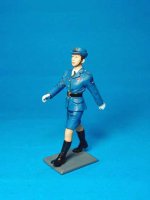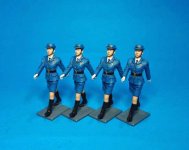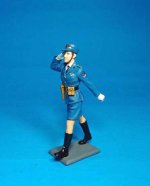Good Morning and welcome to the John Jenkins November announcements, written from a very chilly and foggy San Francisco Bay Area. The grand plan came together, so we were able to do this announcement as planned. Thank you to everyone for the terrific response to October’s New releases.
Because of space limitations this is a 2 part release, so please read both parts.
We have a bumper crop of new releases, in time for Christmas maybe. Just a thought! As always hope you enjoy the new releases as much as I do.
Best regards
Mike
Sierra Toy Soldier
THE GREAT WAR 1914-1918
During 1916 it became clear that in case of a breakthrough, which was the very purpose of the first tank, the Mark I, artillery would have great trouble following the advancing troops. Any successful offensive would therefore be in danger of stalling immediately. To solve this problem Major Gregg, an engineer working for the main tank producing company Metropolitan, Carriage, Wagon and Finance, proposed to build special mechanised artillery, using parts of the Mark I. The production of a prototype was approved on 5 June 1916; the actual design began in July. The first prototype was ready to participate in the Tank Trials Day at Oldbury on 3 March 1917. An order of fifty vehicles was given to Kitson & Co. in Leeds. Deliveries to the army started in June and ended in July.
The vehicle bore little resemblance to the Mark I Tank. The tracks weren't tall but low, almost flat. At the back a rectangular superstructure covered the Daimler 105 hp engine together with the transmission of the Mark I, the latter now in a reversed position. Sharing it were the vehicle commander, a mechanic and two gearsmen. The original double tail wheel of the Mark I, intended to aid steering and attached to the rear of the vehicle, was retained. The front was an open area with either a 60-pounder (5-inch) field gun or a 6-inch howitzer.
For transporting the gun only the wheels had to be removed from the gun carriage - these were attached to the side of the carrier until needed again. In theory, the field gun could be fired from the vehicle; in reality only the howitzer could be so used. Alternatively the guns could be unloaded through a pivoting cradle assisted by two winding drums driven by the engine. Above the front of the track frame at each side was an armoured cab for the driver on the left and the brakesman on the right. In the prototype these driving positions were directly in front of the superstructure; moving them forward improved visibility, but made communication very difficult - a problem as, in the Mark I, four men (including the gearsmen) had to cooperate to steer the tank.
In July 1917 two Gun Carrier Companies were formed of 24 vehicles each. Probably none of them ever fired a shot in anger. As breakthroughs never materialised the vehicles were ultimately only used as supply tanks. It was calculated a single tank had the same carrying capacity as 291 human porters.
GWB-08 BRITISH GUN CARRIER, MARK I, SUPPLY TANK, 1st Gun-Carrier Company, Tank Corps, 6th August 1918
(17pcs)
Retail us$288
Model dimensions 4” x 12” x 4”
Model Weight 1,742g
**Please note supplies are packaged in a separate box to the main Supply Tank but are included as GWB-08, and the supplies are different from those in GWB-09
Extra supplies and Figures will be supplied separately and available soon.
On the night of the 6th August 1918, 17 tanks were moved to the orchard which lay on the northern outskirts of the town of Villes-Betonneux. These were the new Mark I Supply tanks, and on this occasion were to operate with the infantry , as they were all loaded with infantry supplies.
During the afternoon of the 7th, a column of flame and smoke was seen to shoot skywards from the heart of the orchard. German shell fire which had up to then been, indiscriminatingly bombarding the town and surrounding countryside, focused its attention on the orchard. By the time help had arrived, several tanks had either exploded or had burst into flame.
“Within a very short space of time a party of officers and men were on the scene to give what help was possible in saving the tanks still remaining. But the sight presented to their gaze was sufficient to daunt even the most courageous. Several tanks were burning fiercely, as their petrol tanks having being pierced and the contents set alight. In all directions loads of bombs were exploding with loud reports. At any moment the gun cotton charges carried on each tank for demolition purposes might catch, and from overhead fell a torrent of shrapnel and high explosives. One more tank exploded and the party dropped in the ditch behind the orchard hedge while tons of metal were hurled high in the air and the cargo of bursting bombs whistled past their heads. The heat from exploding and burning tanks bunt black the hedge before them, but there still remained several tanks untouched and into the heat of this luid inferno dashed the rescue party.
Fourteen tanks were completely destroyed on this memorable afternoon, and the hope which had run high among the officers and men that the company would make history during the coming operations faded away. The remaining tanks, however, were to adhere to the original arrangements and their crews were the envy of those whose tanks were now a thing of the past.”
Extracts from “TANKS AND TRENCHES” Edited by David Fletcher.
Extra supplies are now available, and should not be confused with the supplies that are included with the Supply Tank
GWB-09 EXTRA SUPPLIES,
(16pcs)
Retail us$75
KNIGHTS OF THE SKIES
Edward Vernon Rickenbacker (October 8, 1890 – July 23, 1973) was an American fighter ace in World War I and Medal of Honor recipient.
With 26 aerial victories, he was America's most successful fighter ace in the war.
He was also a race car driver and automotive designer, a government consultant in military matters and a pioneer in air transportation, particularly as the longtime head of Eastern Air Lines.
ACE-16P Captain E. V. “EDDIE” RICKENBACKER,
(1pc)
Retail us$39
RNAS Armoured Car units were crewed by seamen. The officers normally wore the single breasted Class III blue serge uniform with gaiters. Equipment would have been the 191 Pattern “equipment for Seamen” which included a revolver with its special ammunition pouch with loops , which were designed for ready-use rounds.
This officer has two chevrons which indicate eight years of unblemished service.
BGC-03B ROLLS ROYCE ARMOURED CAR, PETTY OFFICER, CREWMAN, 1915
(1pc)
Retail us$38
THE SEVEN YEARS WAR - THE BATTLE OF LEUTHEN 1757
The Roth Wurzberg Infantry were mercenary troops in Austrian service. The regiment was raised in 1757 from troops from the three existing Wurzburg infantry regiments.
ROT-03 Roth Wurzburg Infantry Regiment, 2 Figures, Loading and at the Ready,
(2pcs)
Retail us$78
ROT-03N Roth Wurzburg Infantry Regiment, 4 Figures, Loading and At The Ready,
(4pcs)
Retail us$138
THE RAID ON ST. FRANCIS
RSF-15 Woodland Indian Running with Musket,
(1pc)
Retail us$39
THE BATTLE OF THE PLAINS OF ABRAHAM 1759
The 35th Regiment of Foot was active in North America during the French and Indian Wars, from 1756 until 1763.
The unit was probably best known for having served at Fort William Henry, during the siege, when the fort was overwhelmed by French forces commanded by General Montcalm.
They were also to see action at the Battles of Louisbourg and Quebec at the Battle of the Plains of Abraham.
QB-40 British, 35th Regiment of Foot, Grenadier Marching #3
(1pc)
Retail us$42
QB-40N British, 35th Regiment of Foot, Grenadier Marching, Box Set#3
(4pcs)
Retail us$138
End of Part one.
Because of space limitations this is a 2 part release, so please read both parts.
We have a bumper crop of new releases, in time for Christmas maybe. Just a thought! As always hope you enjoy the new releases as much as I do.
Best regards
Mike
Sierra Toy Soldier
THE GREAT WAR 1914-1918
During 1916 it became clear that in case of a breakthrough, which was the very purpose of the first tank, the Mark I, artillery would have great trouble following the advancing troops. Any successful offensive would therefore be in danger of stalling immediately. To solve this problem Major Gregg, an engineer working for the main tank producing company Metropolitan, Carriage, Wagon and Finance, proposed to build special mechanised artillery, using parts of the Mark I. The production of a prototype was approved on 5 June 1916; the actual design began in July. The first prototype was ready to participate in the Tank Trials Day at Oldbury on 3 March 1917. An order of fifty vehicles was given to Kitson & Co. in Leeds. Deliveries to the army started in June and ended in July.
The vehicle bore little resemblance to the Mark I Tank. The tracks weren't tall but low, almost flat. At the back a rectangular superstructure covered the Daimler 105 hp engine together with the transmission of the Mark I, the latter now in a reversed position. Sharing it were the vehicle commander, a mechanic and two gearsmen. The original double tail wheel of the Mark I, intended to aid steering and attached to the rear of the vehicle, was retained. The front was an open area with either a 60-pounder (5-inch) field gun or a 6-inch howitzer.
For transporting the gun only the wheels had to be removed from the gun carriage - these were attached to the side of the carrier until needed again. In theory, the field gun could be fired from the vehicle; in reality only the howitzer could be so used. Alternatively the guns could be unloaded through a pivoting cradle assisted by two winding drums driven by the engine. Above the front of the track frame at each side was an armoured cab for the driver on the left and the brakesman on the right. In the prototype these driving positions were directly in front of the superstructure; moving them forward improved visibility, but made communication very difficult - a problem as, in the Mark I, four men (including the gearsmen) had to cooperate to steer the tank.
In July 1917 two Gun Carrier Companies were formed of 24 vehicles each. Probably none of them ever fired a shot in anger. As breakthroughs never materialised the vehicles were ultimately only used as supply tanks. It was calculated a single tank had the same carrying capacity as 291 human porters.
GWB-08 BRITISH GUN CARRIER, MARK I, SUPPLY TANK, 1st Gun-Carrier Company, Tank Corps, 6th August 1918
(17pcs)
Retail us$288
Model dimensions 4” x 12” x 4”
Model Weight 1,742g
**Please note supplies are packaged in a separate box to the main Supply Tank but are included as GWB-08, and the supplies are different from those in GWB-09
Extra supplies and Figures will be supplied separately and available soon.
On the night of the 6th August 1918, 17 tanks were moved to the orchard which lay on the northern outskirts of the town of Villes-Betonneux. These were the new Mark I Supply tanks, and on this occasion were to operate with the infantry , as they were all loaded with infantry supplies.
During the afternoon of the 7th, a column of flame and smoke was seen to shoot skywards from the heart of the orchard. German shell fire which had up to then been, indiscriminatingly bombarding the town and surrounding countryside, focused its attention on the orchard. By the time help had arrived, several tanks had either exploded or had burst into flame.
“Within a very short space of time a party of officers and men were on the scene to give what help was possible in saving the tanks still remaining. But the sight presented to their gaze was sufficient to daunt even the most courageous. Several tanks were burning fiercely, as their petrol tanks having being pierced and the contents set alight. In all directions loads of bombs were exploding with loud reports. At any moment the gun cotton charges carried on each tank for demolition purposes might catch, and from overhead fell a torrent of shrapnel and high explosives. One more tank exploded and the party dropped in the ditch behind the orchard hedge while tons of metal were hurled high in the air and the cargo of bursting bombs whistled past their heads. The heat from exploding and burning tanks bunt black the hedge before them, but there still remained several tanks untouched and into the heat of this luid inferno dashed the rescue party.
Fourteen tanks were completely destroyed on this memorable afternoon, and the hope which had run high among the officers and men that the company would make history during the coming operations faded away. The remaining tanks, however, were to adhere to the original arrangements and their crews were the envy of those whose tanks were now a thing of the past.”
Extracts from “TANKS AND TRENCHES” Edited by David Fletcher.
Extra supplies are now available, and should not be confused with the supplies that are included with the Supply Tank
GWB-09 EXTRA SUPPLIES,
(16pcs)
Retail us$75
KNIGHTS OF THE SKIES
Edward Vernon Rickenbacker (October 8, 1890 – July 23, 1973) was an American fighter ace in World War I and Medal of Honor recipient.
With 26 aerial victories, he was America's most successful fighter ace in the war.
He was also a race car driver and automotive designer, a government consultant in military matters and a pioneer in air transportation, particularly as the longtime head of Eastern Air Lines.
ACE-16P Captain E. V. “EDDIE” RICKENBACKER,
(1pc)
Retail us$39
RNAS Armoured Car units were crewed by seamen. The officers normally wore the single breasted Class III blue serge uniform with gaiters. Equipment would have been the 191 Pattern “equipment for Seamen” which included a revolver with its special ammunition pouch with loops , which were designed for ready-use rounds.
This officer has two chevrons which indicate eight years of unblemished service.
BGC-03B ROLLS ROYCE ARMOURED CAR, PETTY OFFICER, CREWMAN, 1915
(1pc)
Retail us$38
THE SEVEN YEARS WAR - THE BATTLE OF LEUTHEN 1757
The Roth Wurzberg Infantry were mercenary troops in Austrian service. The regiment was raised in 1757 from troops from the three existing Wurzburg infantry regiments.
ROT-03 Roth Wurzburg Infantry Regiment, 2 Figures, Loading and at the Ready,
(2pcs)
Retail us$78
ROT-03N Roth Wurzburg Infantry Regiment, 4 Figures, Loading and At The Ready,
(4pcs)
Retail us$138
THE RAID ON ST. FRANCIS
RSF-15 Woodland Indian Running with Musket,
(1pc)
Retail us$39
THE BATTLE OF THE PLAINS OF ABRAHAM 1759
The 35th Regiment of Foot was active in North America during the French and Indian Wars, from 1756 until 1763.
The unit was probably best known for having served at Fort William Henry, during the siege, when the fort was overwhelmed by French forces commanded by General Montcalm.
They were also to see action at the Battles of Louisbourg and Quebec at the Battle of the Plains of Abraham.
QB-40 British, 35th Regiment of Foot, Grenadier Marching #3
(1pc)
Retail us$42
QB-40N British, 35th Regiment of Foot, Grenadier Marching, Box Set#3
(4pcs)
Retail us$138
End of Part one.


